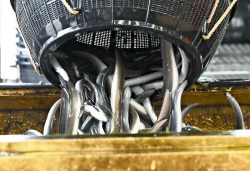13:12 JST, March 8, 2023
WASHINGTON (Reuters) — The small distant world called Quaoar, named after a god of creation in Native American mythology, is producing some surprises for astronomers as it orbits beyond Pluto in the frigid outer reaches of our solar system.
Researchers said last month they have detected a ring encircling Quaoar akin to the one around the planet Saturn. But the one around Quaoar defies the current understanding of where such rings can form — located much further away from it than current scientific understanding would allow.
The distance of the ring from Quaoar places it in a location where scientists believe particles should readily come together around a celestial body to form a moon rather than remain as separate components in a disk of ring material.
“This is the discovery of a ring located in a place that should not be possible,” said astronomer Bruno Morgado of the Valongo Observatory and the Federal University of Rio de Janeiro in Brazil, lead author of the study published in the journal Nature.
Discovered in 2002, Quaoar is currently defined as a minor planet and is proposed as a dwarf planet, though it has not yet been formally given that status by the International Astronomical Union, the scientific body that does such things.
Its diameter of about 1,110 kilometers is about a third that of Earth’s moon and half that of the dwarf planet Pluto. It has a small moon called Weywot, Quaoar’s son in mythology, with a diameter of 170 kilometers orbiting beyond the ring.
Inhabiting a distant region called the Kuiper belt populated by various icy bodies, Quaoar orbits about 43 times further than Earth’s distance to the sun. In comparison, Neptune, the outermost planet, orbits about 30 times further than Earth’s distance from the sun, and Pluto about 39 times further.
Quaoar’s ring was spotted using the European Space Agency’s orbiting Cheops telescope, whose primary purpose is to study planets beyond our solar system, as well as ground-based telescopes.
The ring, a clumpy disk made of ice-covered particles, is located about 4,100 kilometers away from Quaoar’s center, with a diameter of about 8,200 kilometers.
“Ring systems may be due to debris from the same formation process that originated the central body or may be due to material resulting after a collision with another body and captured by the central body. We do not have hints at the moment on how the Quaoar ring formed,” said astronomer and study coauthor Isabella Pagano, director of Italian research institute INAF’s Astrophysical Observatory of Catania.
Unlike any other known ring around a celestial body, Quaoar’s is located outside what is called the Roche limit. That refers to the distance from any celestial body possessing an appreciable gravitational field within which an approaching object would be pulled apart. Material in orbit outside the Roche limit would be expected to assemble into a moon.
Saturn has the largest ring system in our solar system. The other large gas planets — Jupiter, Uranus and Neptune — all have rings, though less impressive, as do the non-planetary bodies Chariklo and Haumea. All reside inside the Roche limit.
But how can Quaoar flout this rule?
“We considered some possible explanations: a ring made of debris, resulting from a putative disruptive impact into a Quaoar moon, would survive for a very short time — but the probability to observe that is extremely low,” Pagano said.
"Science & Nature" POPULAR ARTICLE
-

Genome Study Reveals Milestone in History of Cat Domestication
-

Big Leap in Quest to Get to Bottom of Climate Ice Mystery
-

Security Camera Footage Vulnerable to Outside Access; Investigation Finds 3,000 Pieces Exposed Online
-

Paws on Parade: Nairobi’s Dogs Dazzle at ‘Pawchella’
-

Japanese Eels Escape New Regulation in Vote at CITES Meeting, Avoiding Higher Prices for Dealers and Diners
JN ACCESS RANKING
-

Keidanren Chairman Yoshinobu Tsutsui Visits Kashiwazaki-Kariwa Nuclear Power Plant; Inspects New Emergency Safety System
-

Imports of Rare Earths from China Facing Delays, May Be Caused by Deterioration of Japan-China Relations
-

University of Tokyo Professor Discusses Japanese Economic Security in Interview Ahead of Forum
-

Japan Pulls out of Vietnam Nuclear Project, Complicating Hanoi’s Power Plans
-

Govt Aims to Expand NISA Program Lineup, Abolish Age Restriction























